Related Research Articles

Cristóbal de Morales was a Spanish composer of the Renaissance. He is generally considered to be the most influential Spanish composer before Tomás Luis de Victoria.

Francisco Guerrero was a Spanish Catholic priest and composer of the Renaissance. He was born and died in Seville.
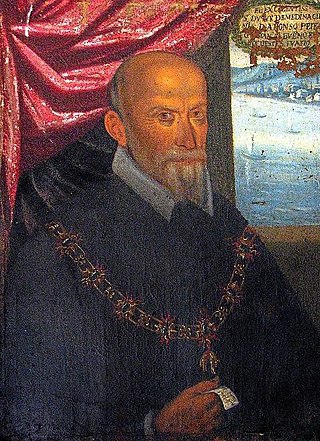
Alonso Pérez de Guzmán y de Zúñiga-Sotomayor, 7th Duke of Medina Sidonia, GE, was a Spanish aristocrat who was most noted for his role as commander of the Spanish Armada that was to attack the south of England in 1588. He was a great-great grandson of Ferdinand II of Aragon.

Sanlúcar de Barrameda, or simply Sanlúcar, is a city in the northwest of Cádiz province, part of the autonomous community of Andalucía in southern Spain. Sanlúcar is located on the left bank at the mouth of the Guadalquivir River opposite the Doñana National Park, 52 km from the provincial capital Cádiz and 119 km from Sevilla capital of the autonomous region Andalucía. Its population is 68,656 inhabitants.

Alonso Lobo was a Spanish composer of the late Renaissance. Although not as famous as Tomás Luis de Victoria, he was highly regarded at the time, and Victoria himself considered him to be his equal.

Luisa Isabel Álvarez de Toledo y Maura, 21st Duchess of Medina Sidonia, GE was the holder of the Dukedom of Medina Sidonia in Spain. She was nicknamed La Duquesa Roja or The Red Duchess due to her lifelong left-wing, anti-Francoist, pro-democracy political activism.

The House of Medina Sidonia is a Spanish noble house originating from the crown of Castile, whose name comes from the Duke of Medina Sidonia, a hereditary noble title that John II of Castile granted to Juan Alonso Perez de Guzman, 3rd Count of Niebla, on February 17, 1445, as a reward for his services to the crown. The Dukedom of Medina Sidonia is the oldest hereditary dukedom in the kingdom of Spain.

Don José Álvarez de Toledo Osorio y Gonzaga, 11th Marquess of Villafranca, Grandee of Spain, jure uxorisDuke of Alba de Tormes, Grandee of Spain was a patron of the artist Francisco Goya.

The Andalusian independentist conspiracy in 1641 was an alleged conspiracy of Andalusian nobility for Andalusia to secede from Spain. The conspiracy was brought to an end in summer 1641 after the plans of rebellion were discovered.
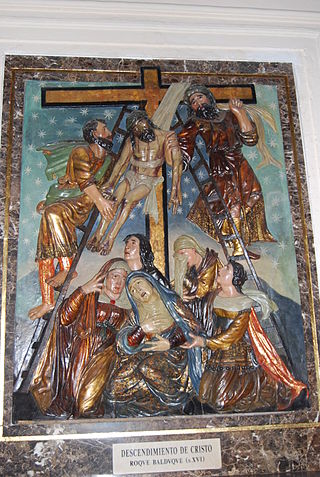
Roque Balduque was a sculptor and maker of altarpieces. Born at an unknown date in Bois-le-Duc, he is known for his work in Spain in the last years of his life.

Duke of Fernandina is a hereditary title in the peerage of Spain. It was granted by King Philip II to García Álvarez de Toledo y Osorio, Viceroy of Sicily and Catalonia, and later Marquis of Villafranca del Bierzo in inheritance from his elder brother. It was conferred on him the 24 December 1559, along with the principality of Montalbán. Fernandina is the only dukedom in Spain that is not attached to a Grandeeship. Its name makes reference to the town of Ferrandina in southern Italy.
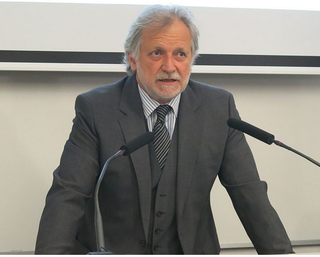
Leoncio Alonso González de Gregorio y Álvarez de Toledo, 22nd Duke of Medina Sidonia, GE is a Spanish aristocrat and historian. Born in Madrid, Medina Sidonia is the eldest son of Leoncio González de Gregorio y Martí and his wife Luisa Isabel Álvarez de Toledo, 21st Duchess of Medina Sidonia. The Duke is Professor of History at the University of Castile-La Mancha and of the Diplomatic School of the Ministry of Foreign Affairs and Cooperation.
Pedro Pérez de Guzmán y Zúñiga was the founder of the House of Olivares, a cadet branch of the House of Medina Sidonia.
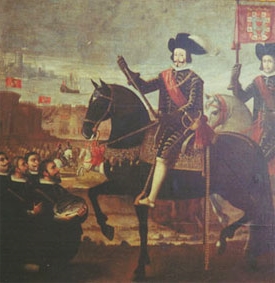
Gaspar Alfonso Pérez de Guzmán y Sandoval, 9th Duke of Medina Sidonia (1602–1664) was a Spanish nobleman who became Duke of Medina Sidonia in 1636, upon the death of his father Juan Manuel Pérez de Guzmán, 8th Duke of Medina Sidonia. He was one of the architects of the Andalusian independentist conspiracy (1641).

Pedro Téllez-Girón y Fernández de Velasco or Pedro Girón, was a Spanish noble, 3rd Count of Ureña and a leader of the Revolt of the Comuneros.

Angela of the Cross Guerrero y González was a Spanish religious sister and the foundress of the Sisters of the Company of the Cross, a Roman Catholic religious institute dedicated to helping the abandoned poor and the ill with no one to care for them. She was canonized in 2003 by Pope John Paul II.

The Señorío de Sanlúcar or Lordship of Sanlúcar was an independent Christian lordship in the Kingdom of Castile located in and around the modern day city of Sanlúcar de Barrameda. It was taken from the Kingdom of Granada in 1295.
The Cancionero de la Colombina or Cancionero Musical de la Colombina (CMC) is a Spanish manuscript containing Renaissance music from the second half of the 15th century.

Pedro de Medina was a Spanish cartographer and author of navigational texts. His well-known Arte de navegar was the first work published in Spain dealing exclusively with navigational techniques.
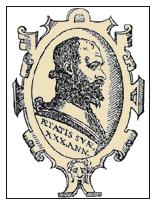
Don Jerónimo Sánchez de Carranza,, Jerónimo de Carranza, Portuguese: Hieronimo de Carança; c. 1539 – c. 1600 or 1608) was a Spanish nobleman, humanist, scientist, one of the most famous fencers, and the creator of the Spanish school of fencing, destreza. He was the author of the treatise on fencing De la Filosofía de las Armas y de su Destreza y la Aggression y Defensa Cristiana from 1569, published in 1582. Carranza created the ideal of a poet and a warrior, which became the main guide to life for noblemen.
References
- ↑ Gómez Fernández, Lucía (2017). Música, nobleza y mecenazgo: los duques de Medina Sidonia en Sevilla y Sanlúcar de Barrameda (1445-1615). Universidad de Cádiz. ISBN 9788498286571. OCLC 1031102131.
- Don Randel. The Harvard Biographical Dictionary of Music, 1996, p. 339.